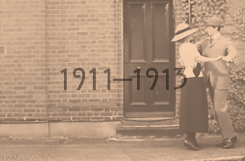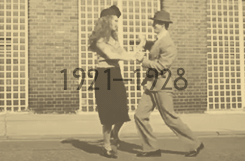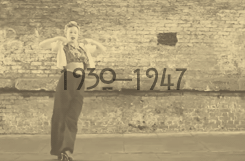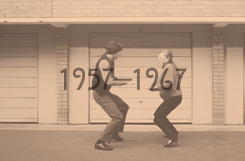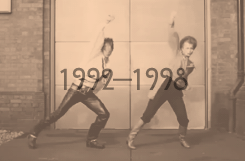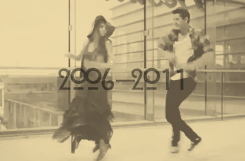Text
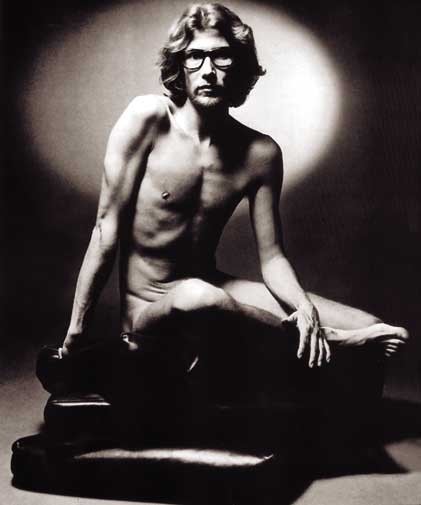
In 1971, Saint Laurent shocked the public when he posed nude for his own perfume advertising campaign. The goal was to force the question, why is it more socially acceptable for a woman to pose nude for an advertisement than for a man? The designer, who successfully maneuvered from couture to ready-to-wear while still keeping the couture house relevant, was the industry’s wonder boy for years. His accomplishments reign impressive, from his initial understanding of the relevance of ready-to-wear to his famous Le Smoking collections to his effortless combinations of fine art and fashion (as made iconic with his Mondrian Dress), the list only continues.
The image for this perfume campaign has often been compared to Jesus of Nazareth and it has since been hard to confirm if this reference was significant to the advertisement itself or only to Yves' public character at the time. Either way, it caused a sensation and not for the last time the designer saw a successful launch of one of his perfumes due to the controversy he created to surround it. Saint Laurent and his long term lover turned business partner, Pierre Berge, were masters of storytelling in various mediums and could rewrite history with understanding of how to present an idea.
1 note
·
View note
Photo
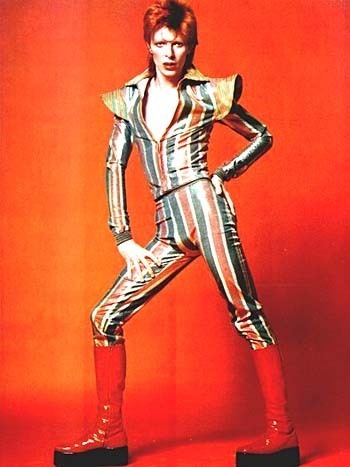
An image chameleon, David Bowie surpasses most in the number of characters and styles that he developed, nurtured and made iconic during his career.
All throughout, Bowie challenged the stereotypes that divided how women and men were supposed to dress. Early on, he established himself as the first rock star to publicly announce his bisexuality. With more than a touch of irony, he posed on his album cover for “The Man Who Sold the World” wearing a calf length satin dress with a deep cut neckline and fitted bodice. Choosing not to wear any makeup and leaving his hair long, loose and curly, he defied the idea that a man in a dress had to be feminine: even in a dress he kept his masculinity intact. The paradox was significant and highlighted the influence of his stage characters later on.
Largely considered his most famous character, Ziggy Stardust was conceived in 1972, bringing glam rock to centre stage. It was this character that influenced the stage performances, public personalities and costumes of countless musical artists that followed, from Kiss to Alice Cooper, Marilyn Manson to Lady Gaga. Ziggy’s style, as seen in this photo, was defined by elaborate makeup, fitted bodysuits and platform shoes, topped with spiky red hair. Not unaware of his effect, Ziggy was retired at the height of his persuasion by Bowie, knowing how to keep the pace and never allowing his creativity and purpose to become stagnant.
4 notes
·
View notes
Photo
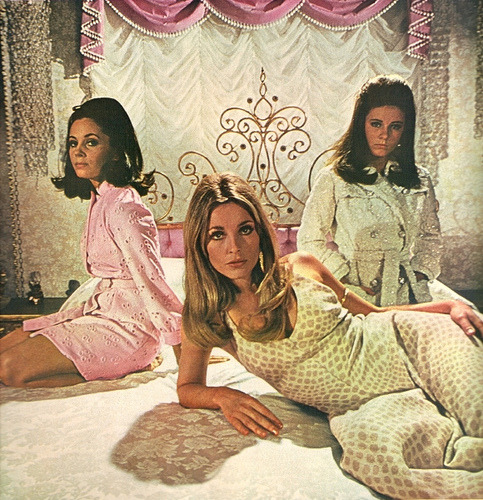
Mark Robson's film, Valley of the Dolls, is a cult classic whose influence can be seen spreading out to a much wider audience.
This image shows the three main characters as they appear before their lives are overcome by tragedy - introduced from the trials and tribulations they face as they seek to become perfect images of themselves. There is a sense of duality throughout the film, between glamour and ugliness, power and weakness and strength versus addiction.
The costuming, by Travilla, has been a running inspiration for designers, stylists and photographers alike. Each character has their own unique style and their clothes are integrated with their personalities and develop the storyline. This is a goal of costume designers that is not easily met, especially with characters as complicated by drugs and fame as these three are. Mind you, coming from the man who dressed Monroe in a fringed potato sack to prove she looked good in everything, I suppose it’s no surprise.
For every still from the film found online, someone has broken down the image to show how it can be recreated today, thereby highlighting the films’ fashion relevance. Mulberry even created a bag after the character “Neely O’Hara”. When discussions were opened up as recently as last year about bringing the film to the small screen, it was official, Valley of the Dolls won't be going anywhere for a while.
62 notes
·
View notes
Photo

French director, Jean Luc Godard directed Band a Part (or Band of Outsiders) in 1964. The costumes, referencing the beatnik movement of the late 1950s, were genius in their understatement. However, it was the cinematographic style of this film that has held the greatest influence over the years.
The French New Wave movement in film history was revolutionary. It created photographic images on film that carry over the generations in their influence and beauty. Band a Part with its dance scene in the cafe, as seen in the still above, is one of the most memorable.
The film saw resurgence in popularity with the release of the Criterion Collection 1984 which ultimately sealed its fate as a staple reference point for filmmakers, critics and artists alike. Its continued relevance inspired the fashion brand Band of Outsiders, by an up and coming design team from New York City, and the film’s style is congruous with the designs for their collections.
8 notes
·
View notes
Photo

Bianca Jagger was the muse of many, from her temporary husband Mick Jagger to famed couturier turned ready-to-wear designer Yves Saint Laurent to pop artist Andy Warhol. She befriended Halston in the 1970s which blossomed into a relationship that lasted for years with Halston designing more than a few outfits, dresses and accessories with her aesthetic and style in mind.
She was publicly recognized as a permanent fixture at the popular Studio 54. In a character-defining moment, she entered the studios astride a white horse, a memory fondly recalled by every guest in attendance that night.
A model, actress and political activist, the latter of which has earned her more awards and honorariums than most people dream of seeing, Bianca successfully borrowed a page from Hepburn’s book and gave it her own spin.
19 notes
·
View notes
Photo
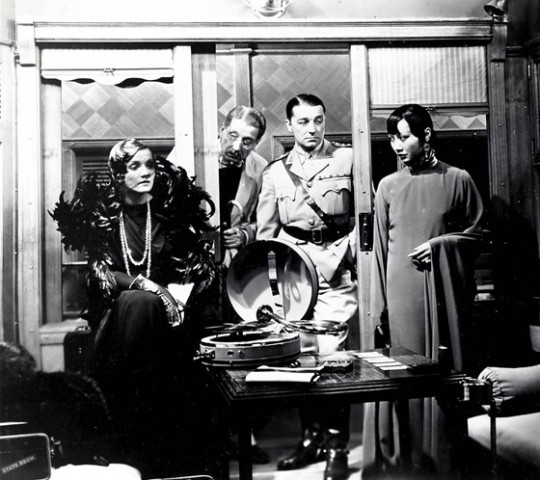
"Don't follow it blindly into every dark alley. Always remember that you are not a model or mannequin for which the fashion is created.”
As the first female fashion icon to bring the concept of androgyny to centre stage while maintaining her sex appeal, Marlene Dietrich was a fashion icon to be reckoned with. Her penchant for menswear staples and ability to pull off masculine three piece suits revolutionized and helped to define women’s fashion. It is with the help of her influence (along with another Hollywood icon of the era, Katherine Hepburn), that pants became an acceptable fashion for women. Though the concept was frequently challenged and not wholly accepted, their persistence allowed the rules of fashion for women to begin to change.
The above still was taken from Shanghai Express starring Dietrichwith Anna May Wong. The film`s influence is widespread and still seen today; Jason Wong`s Fall 2012 took direct inspiration from the 1930s film that exploited the Chinese exoticism, a theme that was popularized during the era. Her costumes’ employment of feathers and dramatic pieces were both glamourous and seductive; it was a new defining style moment for the film star.
2 notes
·
View notes
Photo

Helmut Newton, known for his racy photographs often associated with the evolving sexual revolution of the 1960s and 1970s, took this photo of the original Le Smoking suit by Yves Saint Laurent in 1975. Newton focussed on fashion photography and experimented with fetish nude photography. His style was marked with an eroticism which made his work compelling and slightly dark.
Unsurprisingly, this photographic style was becoming of the suit that launched a women’s wear revolution. As the fight for women’s rights continued to gain momentum, the female population was struggling to find a balance between masculinity and femininity that they could embrace. In 1966, when Yves Saint Laurent sent out a model in a men’s suit down the runway for a Rive Gauche show, the audience witnessed the future of fashion. With perfectly tailored shoulders, Le Smoking suit has come to define the uniform of perfect androgyny and Newtown captured that essence in a photograph.
3 notes
·
View notes
Photo
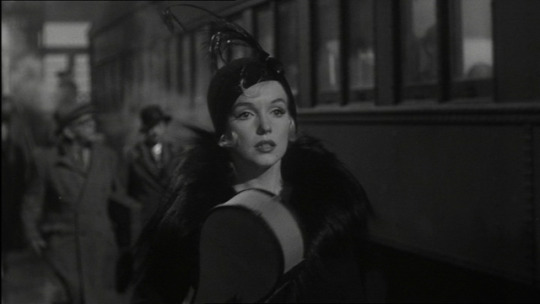
From the white dress blowing up over the subway grate, to the scene from Gentlemen Prefer Blondes “Diamonds are a Girl’s Best friend” or the photo shoot of her naked in bed, it’s impossible not to recognize how widespread the influence of Marilyn Monroe is in image making. The above still, of Hollywood’s biggest export walking through the train station to find her car in “Some Like It Hot” is hard to shake. This scene introduces her character “Sugar Kane” and immediately there is no mistaking Sugar's sex appeal. Throughout the film, the audience falls in love with Sugar, much the same way they fell in love with Marilyn Monroe in her earlier films. This skill, the ability to turn an audience on and have them pay attention, kept Marilyn in the spotlight and America’s hearts for the duration of her short-lived Hollywood career.
Though Monroe did not live long, her image is one of history’s most memorable. It had an enormous impact on the public which Andy Warhol famously acknowledged with his portraits of her. She had achieved the title pop culture icon, possibly to her dismay, though the path to get there was very much chosen and carved by her. Monroe knew how to sell an image. She understood the concepts of archetype and she modelled herself after woman she found attractive. She is one of the most successful people to create an image and sell it. Her public and private personas were very different, if not at odds with each other as she struggled to maintain the character she had laid out for herself. In the end, the character was more than she cared to deal with and ultimately, the image destroyed her.
7 notes
·
View notes
Photo
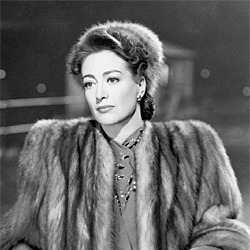
Mildred Pierce was a film noir starring Joan Crawford, the famed foe of Betty Paige. Proving its continued relevance, HBO recreated the film in a 5 part miniseries starring Kate Winslet as Joan Crawford in 2011.
Both Joan Crawford and her most famous character were the ultimate in glamourous style. Milo Anderson designed her costumes for the film which highlight her signature silhouette that focused around strong shoulders. In fact, the creation of this particular silhouette was done specifically for Crawford by Adrian at MGM to add a sense of height to her petite frame. This silhouette came to define the fashions of the 1940s and later re-emerged in an exaggerated way during the 1980s.
1 note
·
View note
Photo

Before Mia Farrow and Vidal Sassoon popularized the pixie cut, Louise Brooks popularized a similar short hairstyle in the 1920s, the angular bob.
A silent film star and distinct beauty, Brooks exemplified simplicity and grace. Following an era that had been epitomized by excess in dress, she preferred a much more minimal style that her audience identified her with. This style was not created by her but came to define the look of the flapper as it allowed her to participate in the new woman`s frivolous and active lifestyle. However, It was Brooke`s hair that earned her the most acclaim and public interest and was the defining haircut of the 1920s flapper.
This hairstyle has become iconic and has been recreated numerous times; from Cyd Charisse in Singin’ in the Rain, Rose McGowan in The Doom Generation and Melanie Griffith in Something Wild. The influence has spanned the decades and continues to do so, as short female hairstyles continuously pop up onto the runways and the red carpet.
The image seen here by Eugene Robert Richee is one of the most fondly recalled photographs of the film star; the high contrast and playful use of an excessively long strand of pearls has been borrowed many times since.
0 notes
Photo
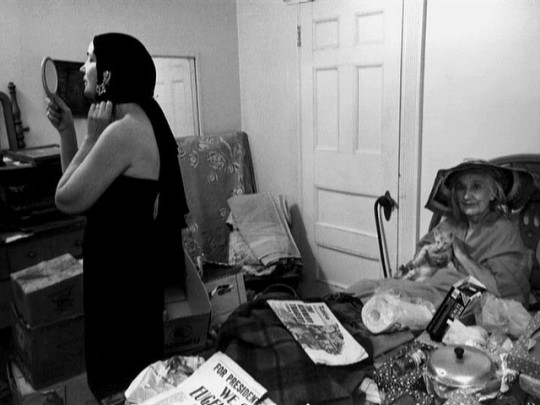
This is a still from the 1975 documentary “Grey Gardens”, a sordid view of the life and style of Edith & Edith Beale, the infamous cousins of fashion’s darling, Jackie O.
While the documentary saw a quick rise in popularity in 2009, when an HBO movie was released of the same name starring Drew Barrymore and Jessica Lange as the mother and daughter team, it had debuted to a lot of negative critique and general disdain. The overwhelming criticism of the documentary when it was originally released, was due to its bias and humiliating revelation of Big and Little Edie.
The film highlights the eccentricities of two of New York society’s elite but it also stepped on the pulse of something else quite different for the time.
Despite living in a mansion on property in the Hamptons, the Beale’s living situation was dire and their house a sty. They lived in impoverished conditions but appeared to have little concept or understanding of their tragic and unusual situation. The relationship between the mother and daughter pair was unhealthy, yet living in complete seclusion, they created a world for themselves in which they could be the centres of attention. Throughout the filming of the documentary, they dressed up for the camera, sang and danced and showed little regret for the conditions in which they lived. With little money and time spent off the property, they were incredibly creative in the fashions that their vanity imposed upon them. Little Edie was going prematurely bald and chose to wrap scarves and old, torn pieces of fabric around her head. They both layered clothing with considerable talent and are common inspirations for layered aesthetics.
10 notes
·
View notes
Photo
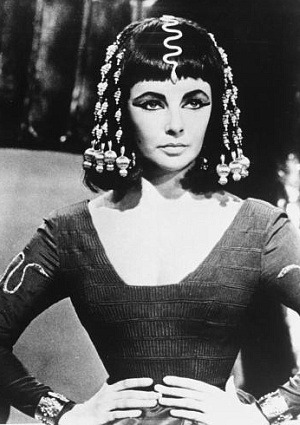
Cleopatra has long been revered for her beauty and her power. However, historical portraits of Cleopatra are crude. While ancient texts weave stories of a powerful queen who bathed in milk, darkened her eyes with heavy amounts of kohl and had men fawning at her feet, there are few images that accurately describe what she looked like. It’s no surprise then, that the 1963 film, starring Hollywood legend Elizabeth Taylor, reigns as the quickest and clearest image to come to mind, even though some of the images are glamourized to a fault and show little concern for historical accuracy.
The film is memorable for a number of reasons. Considering inflation, Cleopatra was the most expensive film ever produced. Despite it being the highest grossing film of the year, it managed to run at a significant loss and nearly bankrupt Fox films when it ran $42 million dollars over budget. It was on the set of Cleopatra that Elizabeth Taylor began her highly publicized affair with Richard Burton; an affair still revered today and caused a storm in the tabloids of the time.
Elizabeth Taylor’s version of Cleopatra manages to be the most decadent, which is of little surprise when you consider her honour of most costume changes in a film (a whopping 65) until Madonna surpassed her in Evita (with an incredible 85). Her costumes were designed by styling team Renie Conley, Vittorio Nino Novarese and Irene Sharaff and their hard work won them an Oscar for best costume in a colour film.
2 notes
·
View notes
Photo
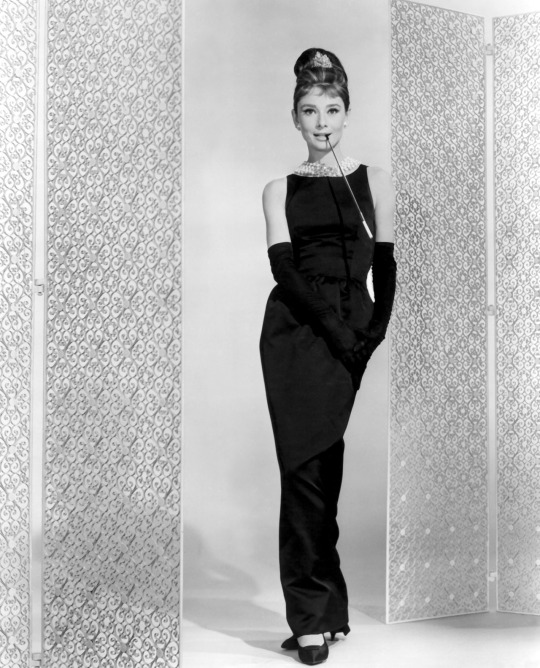
One of the most recreated, re-emulated and iconic images of all time, this promotional shot of Audrey Hepburn for Breakfast at Tiffany’s has stood, and will continue to stand, the test of time. It was through this dress that the concept of the little black dress surpassed its previous potential, even after gaining notoriety as a fashion staple through the work and genius of Gabriel Coco Chanel. Versions of this empire waist by designer Givenchy are seen on the runway every year during the assorted shows in every major fashion capital.
Notably, the relationship of artist and muse between Givenchy and Hepburn is an example of one of the most successful. The collaboration of their efforts created key looks that have become mandatory references for everyone interested or involved in fashion. A brief glance at their joint portfolio demonstrates why.
Audrey was one of two women in history to ever wear the famed Tiffany’s 128 karat canary diamond necklace – the centrepiece you see here in her multi-stranded pearl necklace. From this film, she popularized the hairstyle of high contrast blonde highlights, a trend that resurfaces every few years. Stylists, magazines and celebrities constantly reference the glamourous image of pearls with dark, toroiseshell sunglasses (a now classic frame for eyewear company RayBan), a glittering tiara and long cigarette holder.
9 notes
·
View notes
Photo
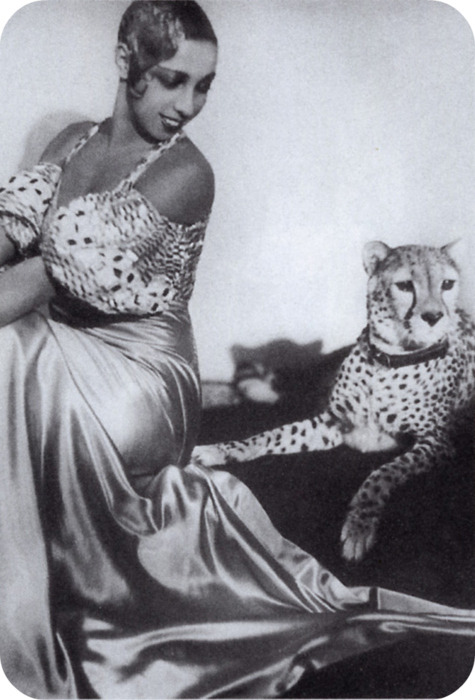
Josephine Baker , one of the most admired and well paid entertainers in Europe, was a mainstay of the Paris expat scene. She was beautiful, elegant and embodied the Art Deco movement of the time. She started a trend with her signature hairstyle, as it was easy to wear under the period’s trademark cloche hat.
She was famous for her lavish taste and signature performances. Her banana dance is one of the most referenced burlesque acts in history and her penchant for gold baubled accessories and chic hats influenced the styles of her time as well as today.
Her pet cheetah, Chiquita was a gift from her club owner, Henri Varna. She not only used it in her acts at Varna’s theatre but took it everywhere she went, decked in a diamond choker. The wild cat complemented the duality of her public image; half exotic and untamed and half elegant and sophisticated.
25 notes
·
View notes
Photo

Diana Vreeland’s role was behind the lens and she helped to define the role of a stylist that we see today. This photo, shows her at work with Richard Avedon and his favourite model, Dovima and visually demonstrates her strong presence behind the scenes. Her list of accomplishments is long; she worked at Harpers Bazaar as Fashion Editor then later moved to Vogue to become Editor in Chief and finally became a consultant for the Costumer Institute at the Met, where she helped to curate the shows and ultimately changed how the curation of fashion would be approached.
Vreeland was known to be highly quotable and her first work in the industry was writing the now infamous column “Why Don’t You” for Harper’s Bazaar. She discovered Edie Sedgewick and Lauren Bacall and was the only credited stylist of Jackie O. Her work challenged the traditions of beauty, society and success and it was her influence that ultimately created the room and the position in which Anna Wintour can now shine.
22 notes
·
View notes
Photo
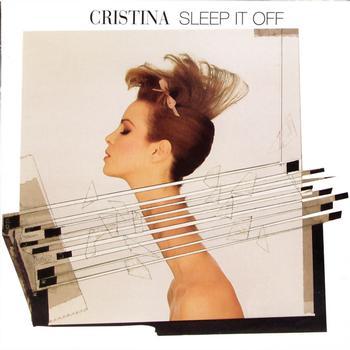
Cristina Monet was a Harvard student, born of wealthy parents, who dropped out to pursue more artistic efforts; beginning as a writer for the Village Voice and later as a recording artist, funded by her first husband, Michael Zilkha.
She stood out against the grain of the early eighties, as her ironic and humourous (though at times heavy) lyrics were displaced by the playful music of the new wave genre. In her short recording career, she was compared to and even rivalled against Madonna and if she was still recording today, similar comparisons could be made to Lady Gaga.
However, she was coming from a different place than these two artists; while Madonna and Lady Gaga are outsiders who are trying to get in, Cristina used her position as a high society insider to mock the lifestyle in her music. Monet created an image of juxtaposition. Positioning herself against the grain of society’s elite, she chose body-manipulating artwork and extreme fashions to help challenge the culture by which she grew up surrounded. The cover artwork seen here was by Jean-Paul Goude. The image fills the viewer with questions. While a long neck is often considered beautiful, the cut-up image seems at once painful and grotesque and challenged the concept of beauty and elegance.
This album cover was chosen for its remarkable similarity to Grace Jones’ album cover, also developed by Goude, but was released a year later. As Cristina played a significant role in the creation of her image and in all art involved her music, she most likely played a role in the creation and vision of her album covers. As she was distributed on a very small scale, she can be seen as a direct influence to those who were exposed to her art.
36 notes
·
View notes
